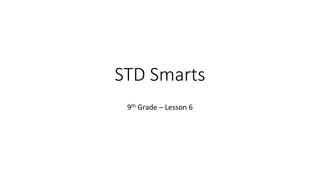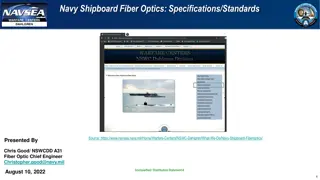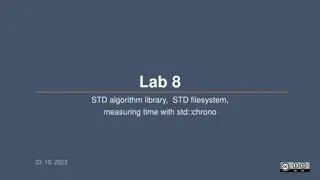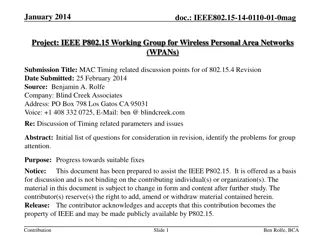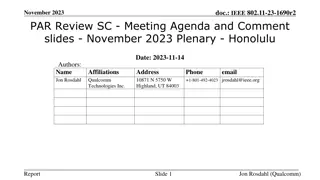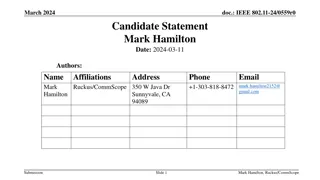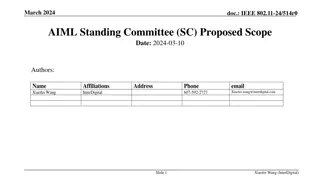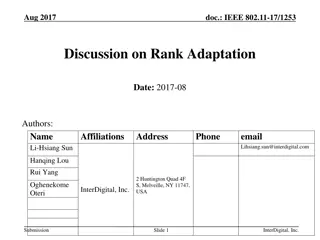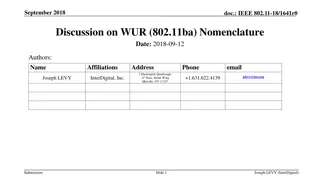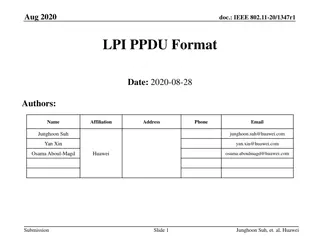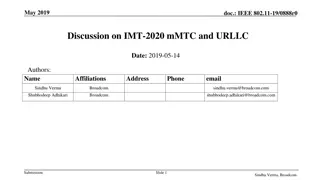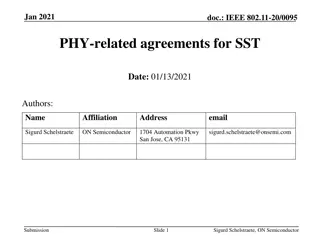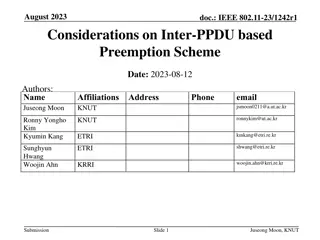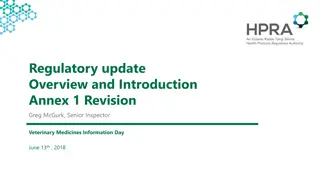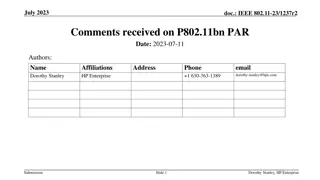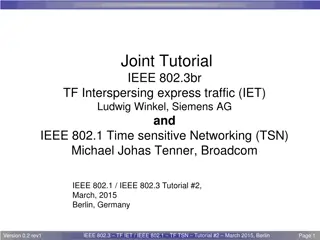Proposed Revision of IEEE Std. 802: Key Aspects and Recommendations
Proposed revision of IEEE Std. 802 involves high-level views of IEEE 802 networks, updates to reference models, adjustments to general requirements, network management enhancements, and revisions to MAC addresses and protocol identifiers. The focus is on streamlining and optimizing various aspects to align with evolving technology standards.
Download Presentation

Please find below an Image/Link to download the presentation.
The content on the website is provided AS IS for your information and personal use only. It may not be sold, licensed, or shared on other websites without obtaining consent from the author. Download presentation by click this link. If you encounter any issues during the download, it is possible that the publisher has removed the file from their server.
E N D
Presentation Transcript
1 Mentor DCN 802.1-21-0060-00-ICne ELLA: Proposed Aspects of IEEE Std 802 Revision Roger Marks (EthAirNet Associates) roger@ethair.net +1 802 capable 7 October 2021
2 IEEE Std 802 - History IEEE Std 802-1990 IEEE Std 802-2001 IEEE Std 802a-2003: Playpen EtherTypes IEEE Std 802b-2004: OID hierarchy IEEE Std 802-2014 IEEE Std 802c-2017: Local MAC Address Usage IEEE Std 802d-2017: URN allocation P802f: YANG Data Model for EtherTypes WG ballot opened, June 2021 Procedurally, revision should follow before further amendments 2
3 IEEE Std 802 - Contents 1. 2. 3. 4. 5. 6. 7. 8. 9. 10. 11. Annex A (informative) Bibliography Annex B (informative) Reference models for IEEE 802 standards Annex C (informative) Examples of bit ordering for addresses Annex D (informative) List of IEEE 802 standards Annex E (informative) History [Annex F: (informative) YANG representation example (P802f)] Overview, Scope, Purpose Normative references Definitions Family of IEEE 802 standards Reference models (RMs) General requirements for an IEEE 802 network IEEE 802 network management MAC addresses Protocol identifiers Allocation of OID values Allocation of URN values 3
4 Proposal on how to revise 4. Family of IEEE 802 standards (pp 7-10) 4.1 High-level view of IEEE 802 networks: revise; explain the commonality 4.2 List of applications: delete 4.3 Internationalization: minimize 4.4 List of standards and projects: delete 5. Reference models (RMs) (pp 11-18): replace with LL Service & Architecture 5.1 Describes Link Layer (LL) as one LLC over various MACs: replace Describes media-independent handover: delete 5.2 Reference model for end stations (LLC/MAC/PHY): replace 5.3 Interconnection: replace Barely mentions VLANs or priority; no reference to their role in architecture 6. General requirements for an IEEE 802 network (p 19) Replace with conformance-related description of LL service provided to client 7. IEEE 802 network management (pp 20-21): replace 8. MAC Addresses (pp 22-27, plus pp 12-19 of 802c) Revise; merge with LL Service and Architecture 9. Protocol identifiers (pp 28-34) Lists many 802.3 MAC frame formats, without assigning fields to layers Who s responsible for adding and stripping those fields? Replace; merge with LL Service and Architecture 4
5 IEEE Std 802 Proposed Revision 1. 2. 3. 4. 5. 6. 7. 8. 9. 10. Annex A (informative) Bibliography Annex B (informative) Reference models for IEEE 802 standards Annex C (informative) Examples of bit ordering for addresses Annex D (informative) List of IEEE 802 standards Annex E (informative) History Annex F: (informative) YANG representation example Overview, Scope, Purpose Normative references Definitions Family of IEEE 802 standards Network and application scenarios served by IEEE 802 IEEE 802 Link Layer Service and Architecture General requirements for an IEEE 802 network IEEE 802 network management Allocation of OID values Allocation of URN values 5
6 Link Layer Service and Architecture Layers, sublayers, and SAPs LLC & LSAP MAC & MSAP PHY VLAN-aware end station Link Layer (LL) service specification LL Service User and LL Service Provider LL modes Service Characteristics Transparency Data loss, data insertion, data duplication, misordering, priority, QoS, time-sensitivity, flow control, LL Service primitives LL Service parameters LL Service sequences of actions and events MAC service specification Refer to IEEE Std 802.1AC LSAP addresses and protocol discrimination MAC address Bridging and relay architecture 6




